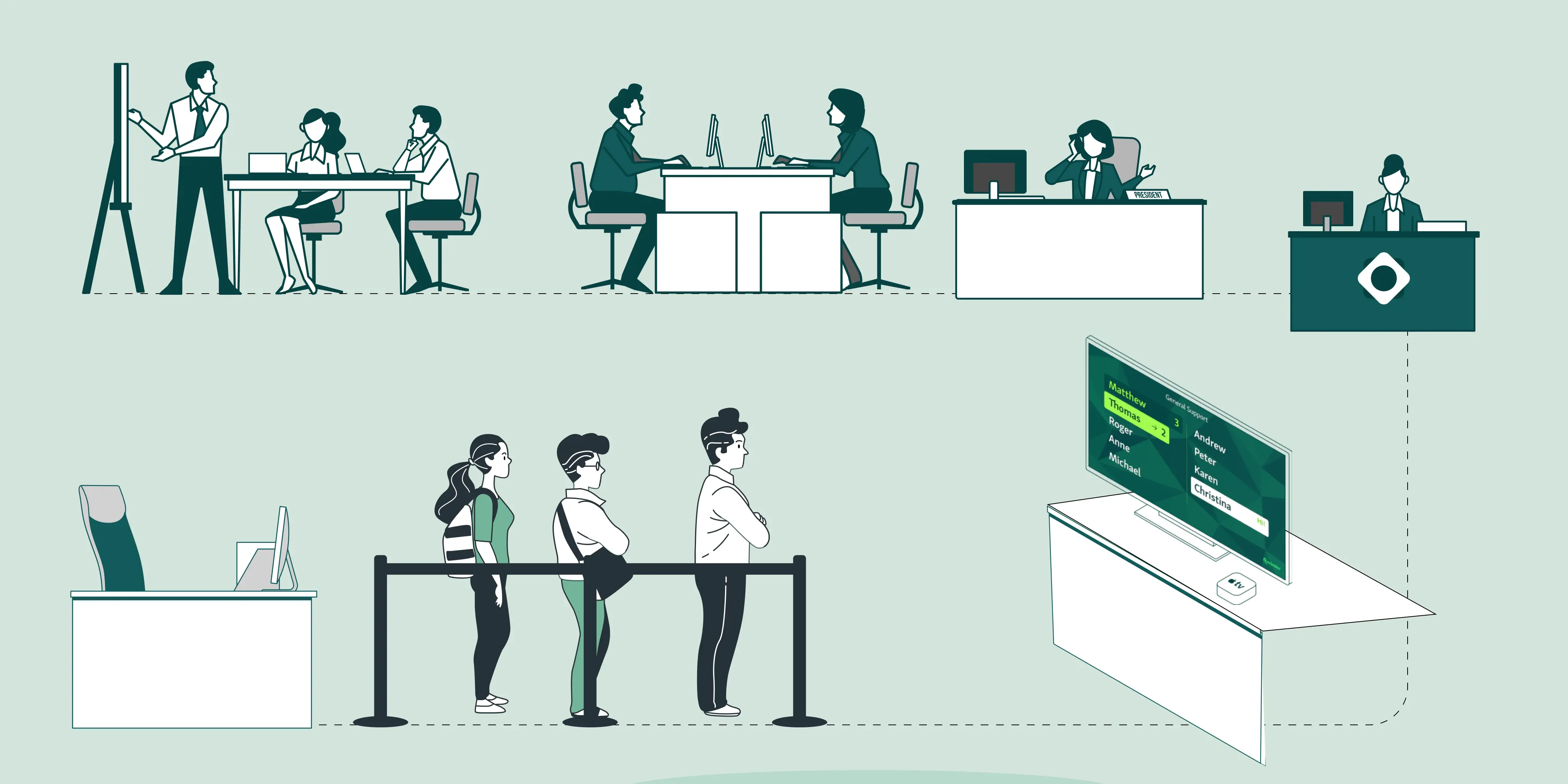In recent years, the public sector has undergone significant transformation. Government offices worldwide are no longer just focused on delivering services—they’re prioritizing efficiency, timeliness, and citizen satisfaction.
However, public services often face challenges such as talent shortages, budget constraints, and increasing pressure from taxpayers to provide better experiences. Addressing these challenges requires innovative solutions that go beyond traditional methods.
One of the most overlooked aspects of public service is the waiting experience. Long lines and disorganized queues can lead to frustration and dissatisfaction, undermining the perception of government efficiency.
So how does implementing a government queue management system help this situation in any way?
1. Improves citizen flow
The most obvious benefit of employing a digital queue management system in government offices is that it drastically improves citizen flow. As self-service sign-in smoothens the registration process, visitors of public service offices join the right line in a matter of second.
Coupled with attention-grabbing digital signage, government queuing tools help keep citizens informed and steadily progressing. Serving more visitors in less time leads to higher satisfaction for citizens and fulfilment for employees.
A better queuing flow also helps reduce cancellations and no-shows, which occur predominantly in cases where expected wait times are too high.
2. Gives citizens free time
Joining a virtual queue instead of a physical line offers citizen freedom, as they are no longer required to stand in line to keep their spot.
A text message sent to a visitor’s phone number will alert them of their turn coming up soon. Knowing this, the visitor can return to the waiting area without wasting their time standing in lines.
With the fear of missing out on their turn out of the way, visitors of government offices can go about their business. This results in a smoother and more satisfying queuing experience.

3. Empowers staff
By leveraging queuing technologies, employees at government offices can recognize and eliminate service holdups on the fly.
Public services tend to be quite fragmented and confusing to an outsider. What happens when a visitor joins the wrong physical line? Either a clerk needs to identify the problem and manually direct them to the right line, or the visitor needs to leave their spot in a queue and start over.
This is a huge waste of time and effort.
On the other hand, virtual lines do not require visitors’ physical presence. If a visitor is in the wrong line, they can be moved to the right one with just a few clicks. What’s more, since the waitlist is on the screen at all times, other visitors can immediately spot the change.
This is only one example of removing hurdles in a queuing process, but you may find more applications for a government queuing app.
4. Improves staff conditions
It can be emotionally and physically draining to serve frustrated visitors. Unfortunately, public service offices are traditionally the breeding grounds for exactly that kind of visitors.
The good news is that once you eliminate the biggest source of frustration — long, chaotic, skull-numbingly boring waiting lines — the visitors become much more calm and relaxed. Happier staff equals happier visitors, but the same is true vice versa.
Because digital queuing systems bring down the time needed to sort administrative tasks, they serve to improve the working conditions of government employees.
5. Easier communication
One of the more common complaints about government offices is that there is little to no communication from managers. Digital queuing systems eliminate this issue entirely.
If you have the text chat option enabled for your Qminder account, your staff can exchange text messages with visitors who have shared their phone numbers upon sign-in. This way, you could not only notify them of their turn but also remind them to bring necessary papers.
Meanwhile, citizens can request more information or warn that they will be unable to come on time, thus letting clerks serve the next visitor on their waitlist. No time wasted.
6. Cuts down on costs
When it comes to improving visitor management processes in government offices, there are budgetary constraints to keep in mind. That’s why it’s critical to balance the efforts to provide better service with budgetary limitations.
A cloud-based waitlist management solution helps reduce costs by improving resource allocation while not requiring any additional on-site staff to handle the system’s technical side.
The system is on autopilot, reducing no-shows and improving visitor management efficiency, while employees — freed from having to manually manage traffic — can focus on other tasks.
All of this while saving taxpayer dollars.
Read also - Queue Management Systems: Cost vs. Benefits Analysis for Public Sector Agencies
7. Keeps track of real-time insights
If your public service office is not using a digital queue management system, you’re missing out on valuable data. The Qminder queue management system lets you control and measure the quality of your service by tracking and reporting important metrics, offering valuable insights for government analytics.
Qminder helps you better understand your citizens, by providing in-depth real-time service intelligence of visitor behavior. By personalizing your service, using the data that citizens provide upon sign-in, you can meet the needs of your visitors.
You can also identify overall trends — such as no-shows, walkaways, service time, etc. — and parts of the queuing process that require more input from you, and allocate more resources to the places that need it.
Learn from every interaction and continue making your public service even better, without adding to your workload.

8. Respects data privacy
Government offices cannot get a break. There are budgetary constraints, and then there’s the ongoing pressure of regulatory changes and data privacy.
Paper solutions, such as sign-in sheets, do not satisfactorily cover the needs for safe handling of data. Paper sheets can easily be lost or even stolen, while digital data — provided, of course, that you invest in cybersecurity — remains safe.
Like many other providers of government queuing solutions, Qminder takes security and data privacy seriously. Unlike other providers, it takes an extra step or two to cover all bases.
Qminder backs up user data daily and uses Amazon Web Services (AWS) to store it. Databases are accessible only through the Qminder web servers using an encrypted communication channel. For user authentication, Qminder provides optional single sign-on (SSO).
Moreover, all of Qminder’s web resources use encrypted communications (HTTPS). You can never go one step too far when it comes to data security.
9. Better overall public perception
Experience is only as good as its weakest part, and the weakest part of government office experiences is usually long waiting times.
Initiatives like the Federal Agency Customer Experience Act emphasize the importance of improving these interactions to create smoother, more efficient public service experiences.
Many citizens often ask, “Why does the US government move so slowly?” Adopting digital queue management systems, can transform public service by streamlining queuing demands and addressing technical challenges.
These GovTech solutions help public services deliver better citizen experiences, ensuring smoother interactions and improved satisfaction with government services.
All of the benefits listed above are spices and ingredients — that is, they are already amazing individually, but their true greatness reveals when they are mixed in together.
Better queuing, satisfied staff, powerful analytics, data privacy, and cost-effectiveness — all of this leads to higher visitor satisfaction and, as a result, better public perception of the government offices’ work.
Qminder has proved its worth with many public service providers: City of Torrance, City of Manhattan Beach, Okaloosa County Clerk, City of Richland, and more.
As they say, you are only as good as the company you keep — and when it comes to public service providers, you couldn’t ask for a better company.
Sign up for a free 14-day trial of Qminder and join the ranks of superior citizen champions.






